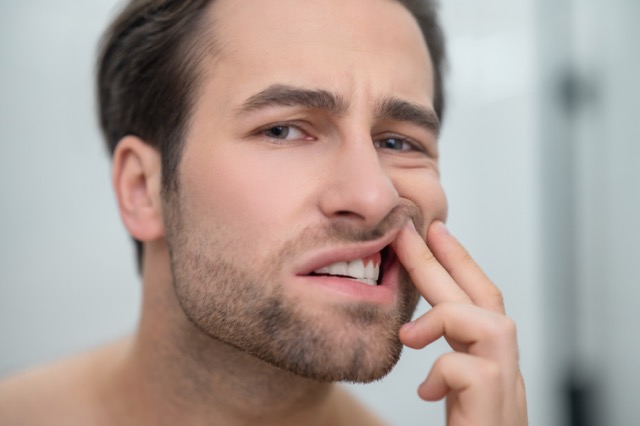What Is Gingivitis? Causes, Symptoms, and Treatment

Contents

If your gums become red, swollen, or bleed, it may be gingivitis symptoms. The condition isn’t likely to pass on its own and can lead to irreversible damage to your oral cavity if neglected. Around 42% of adults over 30 years old have gum disease, so dentists are well aware of the main gingivitis causes and treatment options. Does gingivitis go away in the early stages? Is gingivitis curable? Can gingivitis kill you? Let’s explore how not to let bacteria take over your teeth!
What Is Gingivitis?
Gingivitis is the initial phase of gum disease that occurs when bacteria, plaque, and tartar accumulate on teeth. Bacterial infection affects the gums surrounding the base of teeth, causing swelling, tenderness, redness, and bad breath. If you pay no attention to the condition, it can result in periodontitis and further jawbone loss. Thus, it’s vital to seek medical help as soon as you notice gingivitis swollen gums.
Causes of Gingivitis
The major culprit of gingivitis emergence is dental plaque, a filmy layer of bacteria that can cause inflamed gums. It can build up on your teeth in the following cases:
- Poor oral hygiene. By not keeping your teeth and gums clean, you can soon google “How to combat gingivitis?” Decent gingivitis oral hygiene contributes to gingivitis reversal.
- Smoking. This harmful habit impedes your body’s natural ability to withstand infections.
- Hormonal changes. Fluctuations of sex hormones, especially during pregnancy, can lead to various periodontal conditions.
- Crooked teeth. It might be challenging to clean such teeth along the gum line, which can promote plaque buildup. An orthodontist can fix your bite misalignment with traditional metal braces or more advanced Invisalign treatment.
- Diabetes. Blood glucose impacts the likelihood of gum disease emergence, which increases the risk for diabetes.
- A family history of gum disease. A genetic predisposition to compromised gum health increases your chances of developing gingivitis.
- Over-the-counter medications. Certain drugs can reduce saliva flow, which helps maintain the oral cavity clean. This may occasionally promote gingivitis.
If you discover yourself in one of these risk categories, read on to know the alarming signs of gingivitis.
Symptoms of Gingivitis
How to tell if you have gingivitis? Its symptoms might be hard to detect at first, but they become more noticeable with time. Let’s examine the top 4 signs of this periodontal disease.
- Red, Swollen Gums
How to know if you have gingivitis? You can discover that the gums changed their natural pale pink color to bright or dark red. Ill gums gain puffiness and inflammation instead of the original firmness. The reason for such uncomfortable sensations lies in the work of plaque bacteria.
- Bleeding Gums While Brushing or Flossing
Another sign of gingivitis that may occur while brushing or flossing your teeth is bleeding gums. The best way to ensure you don’t have gum disease is to consult a qualified dentist; you may simply use the wrong cleaning technique.
- Bad Breath (Halitosis)
Bad breath is explainable after eating foods with distinctive flavors, but it is a permanent guest with gingivitis. Unpleasant odor remains even after you brush your teeth or rinse your mouth with mouthwash.
- Tenderness or Gum Recession
Gingivitis may cause gum pain or sensitivity when you chew food or consume cold or hot drinks. If you postpone healing gingivitis, gums can start to gradually loosen and move from your teeth, causing recession.
Stages of Gingivitis
How do u get gingivitis? Three gingivitis stages should occur for the manifestation of gum disease:
- Plaque emergence. A thin, sticky, transparent coating builds on your teeth after you eat foods rich in sugars and starches. This complex bacterial formation is called dental plaque.
- Tartar development. If plaque remains on your teeth for some time, it can turn into tartar. Tartar irritates the gumline by forming a protective film for bacteria. The best way to get rid of this obstinate issue is in-office professional teeth cleaning.
- Gum swelling. Gums surrounding the tooth base become irritated and inflamed. This is how does gingivitis look like.
If you don’t schedule a dental appointment, gingivitis can progress into cavities, periodontitis, and tooth loss.
Treatment and Prevention
You may wonder, “Is gingivitis curable?” To help you restore oral health and control the infection, a dentist will thoroughly remove hazardous bacteria, plaque, and tartar from your teeth. Additional treatment methods encompass:
- Scaling and root planing. The procedure involves deep dental cleaning below your gums. While scaling eliminates tartar, planing smooths the teeth’s roots so that the gums can reattach to them.
- Antimicrobial mouthwash. A doctor can prescribe it to destroy harmful bacteria.
- Dental work restoration. If you have fillings, crowns, or dental bridges that don’t fit right, a dentist can replace them with new ones.
How to get rid of gingivitis at home? In addition to the aforementioned methods, you can avert gum disease by:
- Diligent oral hygiene. Brush your teeth thoroughly twice a day and use floss every day to eliminate bacteria between your teeth.
- Giving up smoking.
- Refraining from food and drinks rich in sugar and alcohol.
Routine dental checkups (at least twice a year) will help you monitor the state of your teeth and gums and manage any suspicious symptoms as soon as they arise.
When to See a Dentist
Untreated gingivitis can lead to periodontitis, so it’s crucial to contact an expert in periodontics as soon as you notice the early symptoms of gum disease. The doctor may inspect your oral cavity for any signs of infection, such as redness, swelling, and bleeding, and also check the state of your jawbone by dental X-rays. The treatment cost and longevity depend on the severity and duration of the existing symptoms.
Frequently Asked Questions About Gingivitis
What is the main cause of gingivitis?
Gingivitis is caused by the build-up of dental plaque, a sticky bacterial film. If you don’t brush and floss your teeth properly, it can irritate the gums and lead to their swelling, bleeding, and tartar formation.
Is gingivitis a virus or bacteria?
The bacteria causing this dental condition can spread through saliva-to-saliva contact from one person to another. Poor oral hygiene heightens the risk of developing gum disease, as well as leukemia or HIV/AIDS.
How long does gingivitis last if untreated?
Gingivitis isn’t the endpoint; it can develop to periodontitis, a more severe form of gum disease. It may progress within several weeks to months.
Are bleeding gums always a sign of gingivitis?
No, but this warning sign induces the need for a dental appointment. Bleeding gums can also be a marker of vitamin deficiencies, hormonal shifts, blood-clotting conditions, and more. You might simply use the wrong brushing or flossing techniques.
Additional Resources
Check on clinical images of gingivitis to compare them with the picture in your oral cavity.












